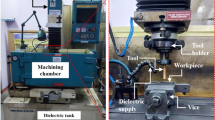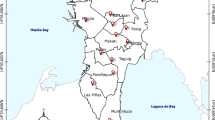Summary
The author has studied the conditions of hemolysis by industrial dusts as the basis for evaluating their biological activity. The resulting hemolysis depends not only on the hemolytic activity of the quartz present, but on particle size distribution, on the mutual interference of hemolytically differently active components, and on the presence of soluble hemolytically effective compounds. The result is so complex that the hemolytic activity test can scarcely by used for the prediction of fibrogenity of the dusts. In laboratory conditions it remains a model of interaction of dust particles with biological membranes.
Similar content being viewed by others
References
David, A.: Haemolysis by fibrogenous dusts as a model of cellular damage (in Czech.). Pracov.Lék. 23, 250–253 (1971)
Einbrodt, H.J., Klosterkötter, W., Robock, K., Hilfenhans, J.: Das biologische Verhalten von isolierten Lungenstäuben im Hämolyse- und Makrophagentest. In: Ergebnisse von Untersuchungen auf dem Gebiet der Staub- und Silikosebekämpfung im Steinkohlenbergbau, Bd.7, 225 S. Detmold: Bösman 1969
Germanó, D., Passantino, G.F.: Azione eritrolitica di alcuni metalli sul sanguè di mammiferi. Med.Lavoro 66, 62–62 (1975)
Glitz, E., Kinny, H., Einbrodt, H.J.: Zur Erythrozytenschädigung durch Bleistäube. Int.Arch.Arbeitsmed. 28, 321–329 (1971)
Harington, J.S., Miller, K., Macnab, G.: Hemolysis by asbestos. Environ.Res. 4, 95–103 (1971)
Herbst, K.H., Einbrodt, H.J.: Mikroskopische Beobachtungen zur Erythrozytenschädigung durch Quarz. In: Ergebnisse von Untersuchungen auf dem Gebiet der Staub- u. Silikosebekampfung im Steinkohlenbergbau, Bd.7, 225 S. Detmold: Bösmann 1969
Ligacz, J., Paradowski, L.: Haemolytic activity of aluminium and its compounds (in Polish). Med.Pracy 23, 41–45 (1972)
Macnab, G., Harington, J.S.: Hemolytic activity of asbestos and other mineral dusts. Nature 214, 522–523 (1967)
Mányai, S., Kabai, J., Kis, J., Suveges, E., Timár, M.: The in vitro hemolytic effect of various clay minerals. Med.Lavoro 60, 331–342 (1969)
Nash, T., Allison, A.L., Harington, J.S.: Physico-chemical properties of silica in relation to its toxicity. Nature 210, 259–266 (1966)
Robock, K., Klosterkötter, W., Scharpenseel, F.: Untersuchungen über die hämolytische Wirkung physikalisch definierter SiO2-Stäube. In: Ergebnisse von Untersuchungen auf dem Gebiet der Staub- und Silikosebekampfung im Steinkohlenbergbau, Bd.7, 225 S. Detmold: Bösmann 1969
Secchi, G.C., Rezzonico, A.: Hemolytic activity of asbestos dust. Med.Lavoro 59, 1–5 (1968)
Schlipköter, H.W.: Tierexperimente und in vitro-Untersuchungen van Asbeststaub. In: II. Internat.Konferenz fiber die biologische Wirkung des Asbestes, Dresden 22.–25.4.1968 (Kurzreferate)
Schnitzer, R.J., Bunescu, G.: Polymers as selective antagonists of hemolytic asbestos fibers. Arch.environm.Hlth 20, 481–482 (1970)
Schnitzer, R.J., Pundsack, F.L.: Asbestos hemolysis. Environ.Res. 3, 1–14 (1970)
Stalder, K.: Der Erythrozyt als Modell für biologische Wirkungen von Stäu-ben. In: Fortschritte der Staublungenforschung, Bd.2, 747 S. Dinslaken: Niederrheinische Drcuk. 1967
Stalder, K.: Zur Hämolyse durch isolierte Lungenstäube. In: Ergebnisse von Untersuchungen auf dem Gebiet der Staub- und Silikosebekämpfung im Steinkohlenbergbau, Bd.8, 242 S. Essen: Glückauf 1971
Stalder, K., Stöber, W.: Hemolytic activity of suspension of different silica modifications and inert dust. Nature 207, 874–875 (1965)
Szentei, E.: Die Hamolyse durch verschiedene Staubarten und ihre Hemmung. In: Fortschritte der Staublungenforschung, Bd.2, 747 S. Dinslaken: Niederrheinische Druck. 1967
Szentei, E.: Die Hamolyse durch Quarzstaub und ihre Hemmung. In: Ergebnisse von Untersuchungen auf dem Gebiet der Staub- und Silikosebekampfung im Steinkohlenbergbau, Bd.6, 183 S. Detmold: Bösmann 1967
Zajusz, K., Kośmider, S., Paradowski, Z.: Detergents as factors modifying the surface of crystalline silica (in Polish). Pol.Tyg.Lek. 25, 1018–1020 (1970)
Zajusz, K., Kośmider, S., Wycislo-Guja, E.: Changes of the haemolytic activity of quartz under the influence of macromolecular substances (in Polish). Med.Pracy 23, 105–108 (1972)
Zajusz, K., Paradowski, Z., Dudziak, Z.: Haemolytic activity of quartz and other dusts (in Polish). Med.Pracy 19, 20–31 (1968)
Author information
Authors and Affiliations
Rights and permissions
About this article
Cite this article
David, A. Hemolysis in vitro in the study of fibrogenity of industrial dusts. Int. Arch Occup Environ Heath 37, 289–300 (1976). https://doi.org/10.1007/BF00380112
Received:
Accepted:
Issue Date:
DOI: https://doi.org/10.1007/BF00380112




